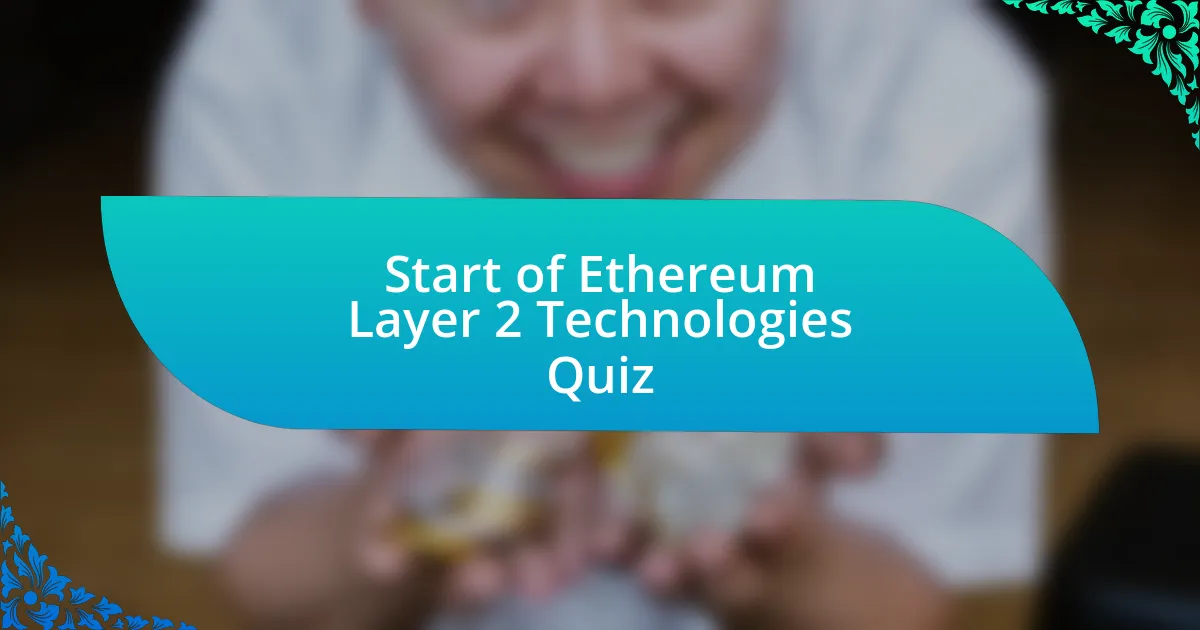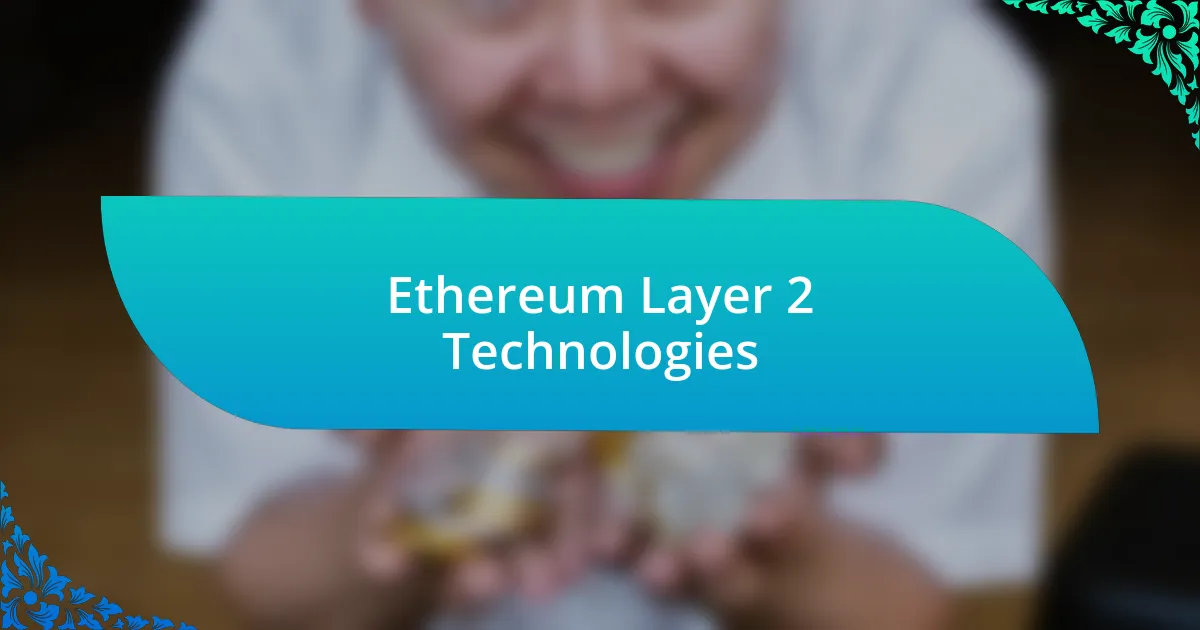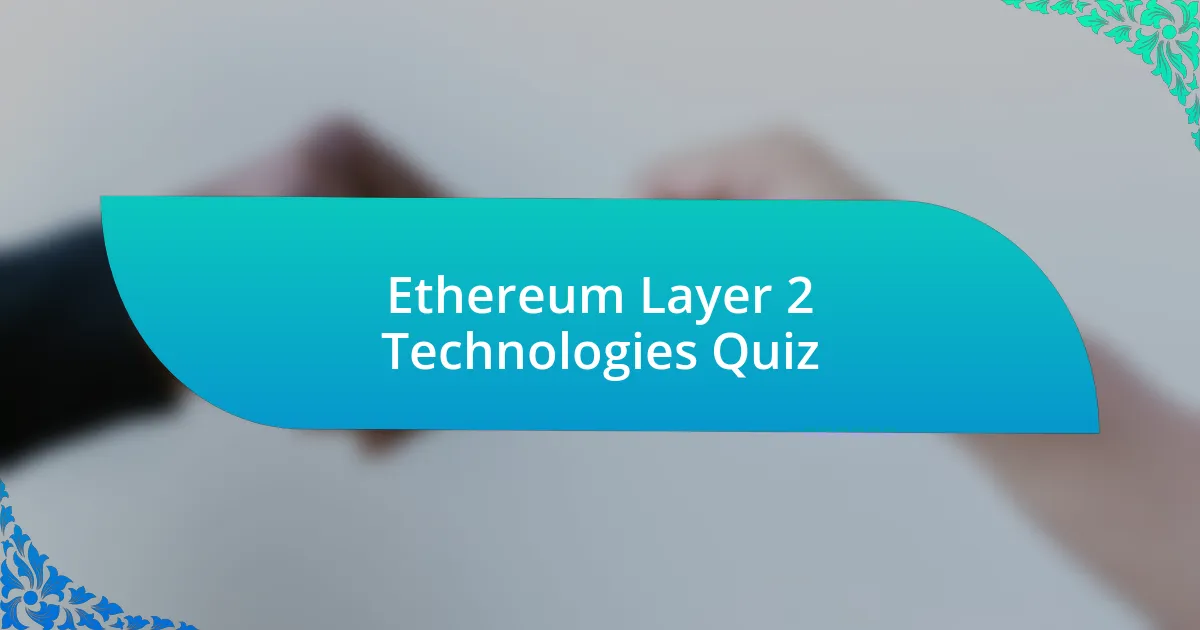
Start of Ethereum Layer 2 Technologies Quiz
1. What is the primary purpose of Ethereum Layer 2 technologies?
- To promote decentralized governance and voting.
- To enhance scalability, reduce costs, and improve user experience.
- To increase energy consumption and carbon footprint.
- To enforce strict privacy regulations in transactions.
2. How do Ethereum Layer 2 solutions address network congestion?
- By increasing the block size of the Ethereum mainnet for faster transactions.
- By introducing new consensus mechanisms that alter the Ethereum protocol.
- By processing transactions off-chain, increasing transaction throughput, and reducing gas fees.
- By limiting the number of transactions per block, allowing only NFT trades.
3. What is the main limitation of Ethereum mainnet in terms of transaction processing?
- It processes transactions in batches of 100.
- It can only process around 15 transactions per second (TPS).
- It can process unlimited transactions instantly.
- It has no limitations on transaction speed.
4. What is the role of validators in Ethereum Layer 2 solutions?
- Validators create new tokens for transactions and distribute them to users.
- Validators are only responsible for mining new blocks and nothing else.
- Validators are responsible for processing transactions, verifying their validity, and ensuring the integrity of the network.
- Validators manage user accounts and wallets in the Layer 2 networks.
5. What is optimistic rollup technology used in Ethereum Layer 2 solutions?
- Optimistic rollup technology eliminates the need for any form of validation or verification of transactions.
- Optimistic rollup technology assumes transactions are valid by default and allows validators to question the validity of a batch of transactions within a week.
- Optimistic rollup technology processes all transactions on-chain to ensure transparency and security.
- Optimistic rollup technology relies on manual approval from users for every transaction.
6. Which Ethereum Layer 2 solution utilizes optimistic rollups?
- ZKSync
- Arbitrum
- Optimism
- Polygon
7. How does Optimism reduce gas fees?
- By bundling multiple transactions into one batch, sharing the cost among users, and submitting the batch to the Ethereum mainnet.
- By limiting the number of transactions that can occur simultaneously on the network.
- By increasing the block size to allow more transactions per block, thus lowering individual fees.
- By introducing a new cryptocurrency that incurs lower transaction fees when used.
8. What is the security mechanism for transactions deemed doubtful in Optimism?
- A two-week review period for users to contest transactions.
- A one-week window for validators to submit and run a fault proof.
- Automatic approval of all transactions without oversight.
- Real-time monitoring by external auditors for immediate verification.
9. What is the purpose of the Optimistic Virtual Machine (OVM) in the Optimism ecosystem?
- To process transactions directly on the Ethereum mainnet for faster confirmation.
- To create new programming languages for developing smart contracts.
- To allow seamless integration of existing Ethereum smart contracts onto the Optimism network without modifications.
- To manage off-chain data storage for improved performance.
10. What is the role of the Optimism bridge in connecting Ethereum mainnet with the Optimism network?
- It enables the seamless transfer of tokens and smart contracts between the two networks.
- It creates new tokens only for the Optimism network.
- It verifies transactions solely on the main Ethereum network.
- It transfers only NFTs between Ethereum and Optimism.
11. What are some common types of Ethereum Layer 2 protocols?
- Flash networks
- Hyperchains
- Quantum channels
- Optimistic rollups
12. How do sidechains help in offloading transaction burdens from the main chain?
- By using a two-way peg mechanism that allows assets to be locked on the main blockchain while issuing corresponding tokens on the sidechain.
- By making sidechains fully independent with no link to the main chain.
- By increasing transaction fees on the main chain to offload processing.
- By requiring all transactions to be directly submitted to the main chain.
13. What is the significance of Ethereum Layer 2 solutions in transforming Ethereum into a globally accessible payment system?
- They address scalability challenges, optimize transaction speed, and reduce costs significantly.
- They increase the minimum required gas price for all transactions, ensuring fair distribution.
- They enable privacy through anonymous transactions, enhancing user confidentiality.
- They restrict access to transactions to only large network participants, improving exclusivity.
14. What is the total value locked in Optimism as of recent data?
- $1 billion
- $250 million
- $772 million
- $500 million
15. Which DeFi platforms support Optimism?
- Coinbase
- Kraken
- AAVE
- Binance
16. How does Optimism achieve faster transaction speeds?
- By implementing faster confirmation times for each individual transaction.
- By processing transactions off-chain and bundling multiple transactions into a single batch.
- By using a proof-of-work mechanism to validate all transactions on-chain.
- By increasing block size limits and allowing larger transactions.
17. What is the impact of Optimism on user experience?
- It slows down the network and limits user access.
- It improves user experience by reducing gas fees and increasing transaction speed.
- It provides no benefits to the user experience.
- It complicates transactions and increases gas fees.
18. What is the primary benefit of using optimistic rollups in Ethereum Layer 2 solutions?
- It reduces gas fees by sharing the cost among users.
- It enhances the speed of the Ethereum mainnet transactions.
- It decentralizes the main Ethereum blockchain completely.
- It increases the maximum block size on the main chain.
19. How does Optimism maintain the trustless nature and security of the blockchain?
- By ensuring that transactions are secured by the Ethereum network and cannot be altered.
- By creating a separate blockchain that does not connect with Ethereum.
- By using centralized servers to validate transactions for security.
- By relying on a single entity to manage all transactions and maintain security.
20. What is the typical method of transaction submission in Layer 2 networks?
- Transactions are submitted to the blockchain without validation.
- Transactions are submitted to external servers for processing.
- Transactions are submitted to nodes rather than directly to the Ethereum Mainnet.
- Transactions are submitted directly to the Ethereum Foundation.
21. What is the function of block producers in Layer 2 networks?
- Block producers act as network administrators for the Ethereum mainnet.
- Block producers are responsible for processing and validating transactions on the Layer 2 network.
- Block producers mine new cryptocurrencies within the Layer 2 network.
- Block producers manage the Ethereum mainnet`s smart contracts.
22. How do Layer 2 solutions ensure the integrity of transactions?
- They use verifiable proof from the secondary network to validate transactions and ensure their integrity.
- They rely on network congestion to enhance transaction verification.
- They automatically approve all transactions without any checks.
- They validate transactions solely based on user reputation.
23. What is the difference between Layer 1 and Layer 2 in Ethereum?
- Layer 1 is a type of Layer 2 that improves security by adding more validators.
- Layer 1 is faster than Layer 2 because it processes transactions directly on the blockchain.
- Layer 1 and Layer 2 have the same function and size in the Ethereum ecosystem.
- Layer 1 refers to the main Ethereum blockchain, while Layer 2 refers to secondary blockchains built on top of Layer 1 to increase scalability.
24. Which Layer 2 solution is the second-largest after Arbitrum?
- zkSync
- Loopring
- Polygon
- Optimism
25. What is the significance of the one-week window in Optimism’s security mechanism?
- It establishes a mandatory transaction submission time frame for users.
- It allows validators to question the validity of a batch of transactions within a week.
- It restricts the number of transactions that can be processed in that period.
- It sets a limit on transaction fees for users during that week.
26. How do Layer 2 solutions address Ethereum’s scalability issue?
- They require users to stake tokens to gain faster transaction speeds.
- They eliminate the need for miners completely, moving to a proof-of-stake system.
- They increase the block size limit, allowing more transactions in each block.
- They process transactions off-chain, increasing transaction throughput and reducing gas fees.
27. What is the impact of Layer 2 solutions on Ethereum’s user experience?
- They limit the number of users who can access the network simultaneously.
- They increase gas fees and slow down transaction speeds.
- They improve user experience by reducing gas fees and increasing transaction speed.
- They make transactions more complex and less user-friendly.
28. What is the primary benefit of using zero-knowledge rollups (ZK-rollups) in Ethereum Layer 2 solutions?
- They limit the number of transactions that can be processed at a time.
- They provide privacy and scalability improvements by processing transactions privately.
- They require off-chain storage for all transaction data.
- They increase transaction fees significantly while processing transparently.
29. How do sidechains connect to the main chain?
- They use centralized databases for transactions.
- They connect via one-way payment systems.
- They rely on direct data sharing without contracts.
- They use a two-way bridge and smart contracts.
30. What is the role of sequencers in Layer 2 networks?
- Sequencers are responsible for ordering and processing transactions on the Layer 2 network.
- Sequencers validate the identity of users on the Layer 2 network.
- Sequencers mine new tokens for the Layer 2 network.
- Sequencers create smart contracts on the Layer 2 network.

Quiz Successfully Completed!
Congratulations on finishing the quiz on Ethereum Layer 2 Technologies! You have taken a significant step in enhancing your understanding of these innovative solutions. Through the questions, you likely explored various aspects of Layer 2 designs and their critical role in improving scalability and efficiency on the Ethereum network. This knowledge is essential as blockchain technology continues to evolve.
Throughout the quiz, you may have learned about key concepts such as Rollups, Plasma, and State Channels. Each technology offers unique advantages that help mitigate user frustration with slow transaction speeds and high fees. Understanding how these technologies work together is crucial for anyone interested in the future of Ethereum and decentralized applications.
If you’re eager to delve deeper into the subject, we invite you to check out the next section on this page. It contains comprehensive information on Ethereum Layer 2 Technologies that will expand your knowledge. Embrace this opportunity to learn more and become well-versed in one of the most exciting areas of blockchain development!

Ethereum Layer 2 Technologies
Understanding Ethereum Layer 2 Technologies
Ethereum Layer 2 technologies are solutions aimed at improving the scalability and efficiency of the Ethereum blockchain. They function by processing transactions off the main Ethereum chain (Layer 1) while still leveraging its security. This separation allows for faster and cheaper transactions, mitigating the congestion that often occurs on the main network. Existing Layer 2 solutions include rollups, state channels, and sidechains, each serving unique use cases while enhancing overall network performance.
Types of Ethereum Layer 2 Solutions
There are several prominent types of Ethereum Layer 2 solutions: Rollups, state channels, and sidechains. Rollups batch multiple transactions into a single one to be processed on Layer 1, which increases transaction speed. State channels create off-chain pathways for transactions, allowing users to interact without constantly referencing the main blockchain. Sidechains operate independently but can interact with Ethereum, allowing for varied applications and experiments without congesting the main network.
Benefits of Layer 2 Technologies
Layer 2 technologies provide numerous benefits, notably increased transaction speed and reduced fees. By offloading transactions, they alleviate pressure on the Ethereum main chain, leading to faster confirmation times. Additionally, they enhance user experience by making decentralized applications (dApps) more cost-effective to use. This improved efficiency aids developers in building scalable applications that can handle larger user bases.
Challenges Facing Ethereum Layer 2 Implementation
While Ethereum Layer 2 technologies offer significant advantages, they also face challenges. Interoperability between Layer 1 and Layer 2 is crucial, as any issues can hinder transactions. Security is another concern, as solutions must ensure that off-chain transactions maintain the same level of trust and integrity as those on the main chain. Furthermore, user adoption requires effective education on how these technologies operate and their benefits.
Future Developments in Ethereum Layer 2 Technologies
The future of Ethereum Layer 2 technologies is geared towards greater integration and enhanced functionalities. Continued development focuses on improving interoperability between different Layer 2 solutions. Innovations in rollups, like zk-Rollups, promise advanced privacy features and reduced costs. As Ethereum upgrades, particularly with Ethereum 2.0, Layer 2 solutions will likely become vital in achieving the network’s vision of scalability, security, and sustainability.
What are Ethereum Layer 2 Technologies?
Ethereum Layer 2 Technologies are solutions built on top of the Ethereum mainchain to improve scalability and transaction speed while reducing costs. These technologies process transactions off the main Ethereum blockchain and then submit the final state back to Layer 1. Examples include Optimistic Rollups and zk-Rollups, which aggregate multiple transactions into a single batch to minimize block space usage and fees. According to a report from ConsenSys, Layer 2 solutions can increase transaction throughput significantly, addressing Ethereum’s scalability issues.
How do Ethereum Layer 2 Technologies work?
Ethereum Layer 2 Technologies work by allowing transactions to be processed off the main Ethereum blockchain. They aggregate transactions into batches, which are validated more efficiently. For instance, Optimistic Rollups operate under the assumption that transactions are valid unless proven otherwise, whereas zk-Rollups use zero-knowledge proofs to confirm transaction validity without revealing the transaction details. This mechanism reduces the computational burden on the Ethereum mainchain, leading to faster and cheaper transactions.
Where can Ethereum Layer 2 Technologies be used?
Ethereum Layer 2 Technologies can be used in various applications, including decentralized finance (DeFi), non-fungible tokens (NFTs), and gaming. They are particularly effective in areas requiring numerous microtransactions, such as gaming platforms. For example, platforms like Arbitrum and Polygon provide a Layer 2 solution that supports DeFi applications with lower gas fees, making these services more accessible to users. Numerous projects are leveraging these technologies to enhance user experience and functionality.
When did Ethereum Layer 2 Technologies emerge?
Ethereum Layer 2 Technologies began gaining significant attention around 2018 when developers started addressing Ethereum’s scalability challenges. The introduction of protocols like Plasma and state channels marked the initial steps towards Layer 2 scaling solutions. The popularity of these technologies surged in 2020 and 2021, coinciding with the explosion of DeFi projects and the increasing gas fees associated with the Ethereum network. This period highlighted the essential need for these solutions to improve network performance.
Who are the key players in Ethereum Layer 2 Technologies?
Key players in Ethereum Layer 2 Technologies include teams and organizations such as Arbitrum, Optimism, and Polygon. These teams are responsible for developing solutions that enhance Ethereum’s scalability. Additionally, major decentralized applications and protocols, like Uniswap and Aave, have integrated Layer 2 solutions to optimize their services. Their collaboration demonstrates the broad support for and reliance on Layer 2 technologies within the Ethereum ecosystem.

